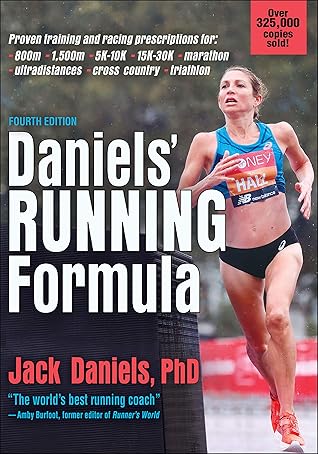More on this book
Community
Kindle Notes & Highlights
Threshold pace would physiologically be at about 85 to 88 percent of O2max (88 to 92 percent of maximum heart rate)
80 to 86 percent values for lesser-tr...
This highlight has been truncated due to consecutive passage length restrictions.
the proper pace is comfortably hard,
two types of T-pace workouts; one is a tempo run and the other is what I refer to as cruise intervals.
tempo run is a steady run lasting about 20 minutes, and cruise intervals are a series of runs at T pace, with a short rest break between the individual runs.
The steady tempo runs are better at building confidence that you can keep up a fairly demanding pace for a prolonged period of time, whereas a session of cruise intervals subjects your body to a ...
This highlight has been truncated due to consecutive passage length restrictions.
Do your tempo runs and cruise intervals at the same designated pace as you find in the VDOT tables
not totaling more than 10 percent of your weekly mileage in a single workout.
maximum of 30 minutes at T pace if the session is broken into cruise intervals.
definition of a tempo run is any run during which the pace of the entire run is performed at T pace,
T-pace runs that last about a steady 20 minutes as true tempo runs.
three 2-mile runs at T pace with 2-minute rests.
one 20-minute run in a single training session is usually enough for most runners.
I (interval) training,
the most varying in definition of all types of training.
purpose of I training is to maximize aerobic power (O2max),
the intensity had to be at or very close to O2max (and maximum heart rate),
good amount of time to spend running at I pace is between 3 and 5 minutes.
It can also be less than 3 minutes,
It takes about 2 minutes to reach O2max when starting out at a resting O2.
a person can stress the aerobic system using a variety of workout durations that are ideally between 3 and 5 minutes each, but the bouts can also be shorter if the recovery time is kept short (less than the time at I pace that each recovery follows).
run six 3-minute H runs, with each being followed by 2 minutes of recovery jogging (jg).
6 × 3 min H with 2 min jg.
runners more often do H-pace runs when at altitude,
For example, to total 20 minutes of H running, you might do either of the following:
2 × 4 min H with 3 min jg + 4 × 3 min H with 2 min jg 1 × 4 min H with 3 min jg + 2 × 3 min H with 2 min jg + 3 × 2 min H with 1 min jg + 4 × 1 min H with
30 s...
This highlight has been truncated due to consecutive passage length restrictions.
The primary purpose of R (repetition) training is to improve anaerobic power, speed, and economy of running.
10 × 400 at 70 seconds each, with 3 minutes of recovery between the faster runs,
running R 400s, jog an easy 400 between the faster runs,
total amount of running to accumulate at R pace (in a single training session) be the lesser of 5 miles (8 km) and 5 percent of weekly mileage.
single work bouts (faster runs at R pace) should not last longer than about 2 minutes each,
E zone (easy runs): Although a variety of running speeds qualify as E runs, I have assigned an average E run intensity as being worth .2 points per minute of running at a speed that represents 66 percent of any runner’s VDOT.
E-zone running to range in intensity from 59 percent to 74 percent of your VDOT value.
M zone (marathon-pa...
This highlight has been truncated due to consecutive passage length restrictions.
between about 75 percent and 84 per...
This highlight has been truncated due to consecutive passage length restrictions.
T zone (threshold running):
mid- to upper-80 percent of VDOT values.
T running is best for improving the body’s ability to clear lactate and, in simple terms, is great for improving endurance.
10K zone: Some runners like to train in the 10K zone, which in my way of looking at training, falls between T and I intensity of effort,
I zone (intervals): The I zone is best for improving aerobic power and makes the body function at, or nearly at, O2max.
typical races associated with the I zone are in the range of 2 miles to 5 miles (3 km to 8 km).
R zone (repetitions) and FR (fast repetitions):
It is in the R zone that a runner spends time working on speed, anaerobic power, and running economy.
Set a realistic goal for every race you run.
term VDOT was originally used as a short form for the O2max value,
dot over the V indicating that the volume, which the V represents, is a 1-minute volume.
The higher VDOT value is associated with the better runner, regardless of age or sex, simply because VDOT represents performance in the first place.
how different weather conditions and


